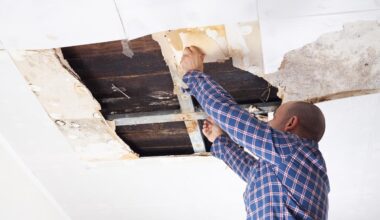If you have a sewage backup in your basement, you must act on it promptly. Knowing what causes this sewage backup and how to stop it from occurring in your basement can help protect you from the health risks associated with sewer clogging. That said, here’s all you need to know about sewage backup in basement, including the cost of cleaning up:
Health Risks Imposed By Sewage Backup In Basement
Some of the health risks imposed ny sewage backup in basement are as follows:
#1. Exposure to E. Coli
E. Coli is a harmful bacteria that can get into contact with you if there is sewage backup and it is outside of your intestines. The most common symptom of this infection is diarrhea, which can lead to dehydration if not treated promptly by doctors.
#2. Exposure to the hepatitis
A virus is another health danger that can be caused by sewage backup. It is not only exceedingly contagious, but it also has a direct impact on your liver. Hepatitis A is characterized by jaundice and an inflamed liver, which is why it is important to be cautious!
#3. Exposure to Heliobacter pylori
Heliobacter pylori is yet another bacteria discovered in sewage. Exposure to this can cause sores or ulcers to form on your stomach and the upper part of your small intestine over time, which can lead to malignant growths termed gastric acid perforation as well as chronic inflammation that causes heartburn symptoms.
#4. Exposure to Acanthamoeba
This is another health risk associated with sewage backup. This is a small, free-living amoeba that can cause serious throat infections. In persons with low immune systems, it has also been associated with serious infections such as nasopharyngitis (upper respiratory infection) and skin deterioration.
All of these can result in a variety of symptoms that, if not treated properly or if the person affected has a suppressed immune system, can lead to severe sickness.
Causes of a Basement Sewage Backup
#1. Clogs
When your home’s drain pipes or the main sewer line become clogged, sewage can back up into your home. If one toilet causes a sewage backup, the drain linked to that toilet is likely to become stuck. However, if all of your toilets or bathtubs backflow, there could be a clog in the main sewer line or the sump pump has failed. Hair, grease, and other solid items that end up in drains can cause clogs.
Tree roots can grow extremely long and interfere with your sewer pipe. Roots can grow into a pipe and produce holes, or they can grow around the sewer line and crush it. Even if the roots in your yard are not the issue, roots from surrounding trees can reach and damage your sewer line.
#2. Sewer Line Damage
In the past, pipes were built of cast iron and clay piping, which did not survive long. Sewage systems that are getting old might break down and crack, resulting in sewage backups and flooded basements. Plastic sewer lines are now commonplace.
#3. Heavy rains
Heavy rain can cause sewer systems in your city to overflow. If the public sewer cannot manage excessive rainfall, the water may enter linked sewage systems. This puts your home at risk of flooding.
How to Stop Sewage Backup in the Basement
#1. Grease should not be poured down the drain
Cooking oil can solidify within your pipes, preventing waste from draining and causing a blockage. Pour grease or fat into a heat-resistant container and dispose of it in the garbage once it has cooled.
#2. Properly dispose of paper items
Paper towels, diapers, and feminine hygiene products flushed down the toilet can easily clog your sewer line. Save yourself the effort and throw away paper products.
#3. Replace the plastic pipe or cut the tree roots
Replace your sewer lateral (the line buried in your yard) with a new plastic pipe to prevent tree roots from destroying it. If tree roots continue to develop in your sewer lateral, trim them every now and again.
#4. Set up a backwater preventer valve
This outlet allows sewage to exit while preventing backup into your home. Backwater valves are often put in a sewage line and, in some cases, in a basement drain pipe.
#5. Maintenance of sewage pumps
Make sure your sump pump isn’t sitting on debris like silt or gravel, which could get sucked up into the pump and destroy the motor. Instead, set it on a stable flat brick. Also, make sure the sump basin is surrounded by a filter mesh to prevent dirt from entering.
How To Clean Up Sewage Backup In The Basement
Understanding the health risks is the first step in learning how to clean up raw sewage in the basement. Utility cables entering a wet basement can be quite dangerous. If you have any concerns about your safety, contact the city’s utility companies immediately and request that your electricity and gas be turned off.
#1. Protect Yourself First
Sewage cleanup exposes you to highly contaminated black water, so put on personal protective equipment before you begin. Rubber gloves and boots, goggles, a face mask, and water-resistant coveralls are required.
#2. Safeguard The Rest Of The House
Close the doors between contaminated locations and non-affected rooms. This decreases the possibility of sewage trash and water tracking through the residence. It also helps to reduce the spread of airborne pollutants.
#3. Determine The Source and Drain
Determine the source of the sewage backup. If you are unable to handle repairs, contact a professional immediately. If the sump pump is working, remove water with buckets or a large-capacity shop vac.
#4. Get Rid Of Everything
Remove everything that has been contaminated by sewage water. Sludge and debris left behind can be removed with push brooms and shovels. Remove as much as feasible. All surfaces that require cleaning and disinfection should be exposed.
#5. Be Prepared To Shovel
Sludge and debris from sewage backups are frequently left behind and should never be removed by hand. Instead, use a shovel to remove it from the floor and place it in heavy-duty plastic bags. Remove the contaminated material as soon as possible.
Sanitation is required if a surface has come into contact with sewage water. Disinfect cleaned and rinsed basement areas with a solution of 1 cup bleach and 1 gallon water.
#6. Remove Flooring
Remove all contaminated flooring caused by sewage water and garbage. Bag vinyl, carpet, and padding securely for fast disposal. If you need assistance with this aspect of the job, make sure you have enough PPE to go around.
#7. Complete with a wet vac
If you have electricity in the basement, use a wet vac to remove any lingering unclean water. Use the device only if it can be plugged into a grounded outlet. Make two or three passes over the entire area.
#8. Rinse and scrub
Scrub all surfaces that have been contaminated by sewage backup. Basement floors, walls, and steps must be thoroughly cleaned with hot water and a low-sudsing detergent before being rinsed with clear, hot water.
#9 Sanitize all surfaces
Sanitation is required if a surface has come into contact with sewage water. Disinfect cleaned and rinsed basement areas with a mixture of 1 cup bleach and 1 gallon water.
#10. Inspect the sump pump
Check that the sump pump is still in good operating order. A sewage backup in the basement can cause the machine to overwork and potentially shut it down. Bring in a professional if you’re not confident with DIY sump pump maintenance.
#11. Begin The Drying Process
Open windows in affected locations if the weather is not too humid. Install huge fans to provide fresh air crosscurrents. Consider renting a powerful dehumidifier. The drying time can range from several days to many weeks.
#12. Clean up
Wash and sterilize your protective gear thoroughly. Make no attempt to save damp garments or cleaning rags. Goods that are dirty can contaminate other items. Take a hot shower and lather up with antibacterial soap or body wash.
#13. Dry The Basement
Open basement windows if the weather permits. Install box fans in corners for cross-ventilation and a heavy-duty dehumidifier. Allow at least three days for the drying process to complete.
#14. Set up inspections
Contact a competent electrician, plumber, and water damage restoration specialist, such as ServiceMaster Restoration by Zaba in Chicago, IL. Schedule a time for each of you to inspect your home. Don’t take any chances because sewage backup damage frequently causes difficulties that aren’t visible.
#15. Inspect for mold
Sewage backup in the basement produces excellent circumstances for a hazardous mold infestation. Even when you clean up the mess, residues of moisture and pollutants might fuel dangerous fungal growth. After any form of downstairs flooding, inspect the basement for mold on a regular basis.
What Is The Cost Of Sewage Backup Cleanup?
The total cost of cleaning a sewer backup in your basement might vary greatly depending on the specific situation and the extent of the damage. The majority of employment will pay between $2000 and $10,000.
Note: Every cleanup situation is unique. Ans so, it is impossible to provide an exact pricing quote over the phone or the Internet. Any true professional will tell you that they must come out in person to check your property and analyze the damage before recommending a solution.
Factors That Determine The Cost Of Sewage Cleanup
#1. Sewage Amount
The volume of sewage involved is one of the most significant cost drivers. The volume of sewage is determined by what caused the sewer line clog and the amount of wastewater involved.
#2. Area Dimensions
The size of the area is another key element in the cost of sewage cleanup. A sewage backup restricted to a tiny laundry room will cost less to fix than if the sewage covers your entire basement.
#3. The length of time the sewage sits
Because water makes up a large portion of sewage, it can permeate through flooring, walls, and cabinetry. The longer sewage is allowed to remain in your home, the more it will soak in and cause damage.
#4. Repairs to the plumbing
Depending on the reason of the backup, you may also require plumbing repairs. Repairing a cracked sewer line, for example, is more expensive than simply clearing a clog.
#5. The Cost of Reconstruction
Sewage cleanup costs also include the cost of repairing and restoring your home. Cleaning and repairing an unfinished basement is less expensive than finishing a family room.
#6. Materials Used
Finally, the materials damaged during the backup can raise the cost. Even if you can save the tile floors, you must have to replace the carpeting. And this will raise the cost.
In Conclusion,
Sewage backup in your basement can pose a lot of health risks. That’s why you should take measures to prevent it from occurring. Even if it does occur, we have outlined steps that you can take to clean up your basement and be free.
Frequently Asked Questions
Why is my drain in the basement backing up?
Water backing up in your basement drain could be caused by a clogged washtub basin or washing machine, tree roots in the drain line, pipe damage, or the flushing of inappropriate materials.
How do I unclog my main basement drain?
A little clog should clear after a few hard plunger pushes. Place the plunger cup so that it completely covers the drain opening, then plunge.
Can sewage backup make you sick?
Sewage contains bacteria, viruses, and other organisms that can cause illness and render a contaminated home unfit for human habitation.
Related Articles
- Septic Clean Out: Costs and How to Clean Out a Septic Tank(
- A Guide to Sewer Scope Inspection 2023: Overview and Importance
- Dehumidifier With Pump: Best 5 Options With Buying Guide
- SUMP PUMP MAINTENANCE: Best Tips To Make Your Pumps Last Longer
- RESIDENTIAL SEPTIC TANK: Home Guide For Your Septic System
- COST TO PAINT CEILING: Everything You Should Know






